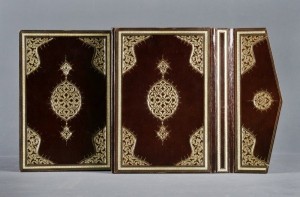
Binding (cilt) refers to the hard-protective cover designed to prevent manuscripts and printed works from being worn or dispersed. This word, which means "leather" in Arabic, refers to the main material of bookbinding. In Islamic book art, bindings are adorned as works of art. Since writing the Qur'an in an artistic calligraphy, illustrating Qur’an with an ornamentation and covering Quran in an aesthetic binding are regarded as almost worship, special attention and care were given firstly to the bindings of Qur'an and then, of all kinds of manuscripts. The first Turkish bindings were made by Uyghur Turks in the 7th century. During the period of Mehmed II (1451-1481), a calligrapher house (nakkaşhane) was established in Ottoman Palace and during the reign of Bayezid II (1481-1512), a bookbinding organization was founded. Artists who work on the bookbinding are called "binder" (mücellit).
Binding materials include leather, cardboard, gold, paint and thread. In addition, binding can be made by using marbling, katı’ (quilling), cloth and precious stones. Hand tools such as mold, decoy, brush, knives, press (mengene) and ıstaka are also used in making the binding. The Ottoman binders used three techniques in bookbinding which were pressing, inlaying and painting.
According to their materials, the binding is categorized as leather, fabric, marbled and lacquer; according to the decoration techniques, they are grouped as şemseli, zilbahar, yekşah, zerduz, çarkûşe.
The 15th century saw a transition from Anatolian Seljuk style to Ottoman style.
In the first examples, the density of geometric ornaments in the bindings is interpreted as the effect of Anatolian Seljuk on the Ottoman style. Developments in the field of bookbinding during the period of Mehmed II, one of the most important periods of Ottoman bookbinding art, were preparatory to the classical era. The color of bindings and quality of the decorative workmanship were eye-catching from the time of Bayezid II. In the classical composite of şemseli, salbekli, köşebentli, the binding was surrounded by borders.
The Turkish bookbinding finds its classical shape in the time of Süleyman I (1520-1566). Floral decorations in the saz style, gilded şemse (ornamental sun figure) and köşebent (corner panel), as well as binding with processed fabric and landscape or floral depicted lacquer, are seen in this period. In addition, inlaid precious gemstones (murassa), which are magnificent examples of the cooperation of the binder and the jeweler, become also widespread. With the decline of the Ottoman Empire in the 17th century, the qualities of the bindings began to decrease. In the 18th century, flower motifs (şükûfe style) dominated the binding. Lacquered binding and binding adorned with realistic motifs become widespread. Motifs of poppy, lotus, hyacinth flowers are used alongside of the classic motifs of roses, clove, tulips, and reddish orange.
Nowadays, bookbinding art is still carried out by traditional methods, but with the development of technology, serial production bindings are also made.




